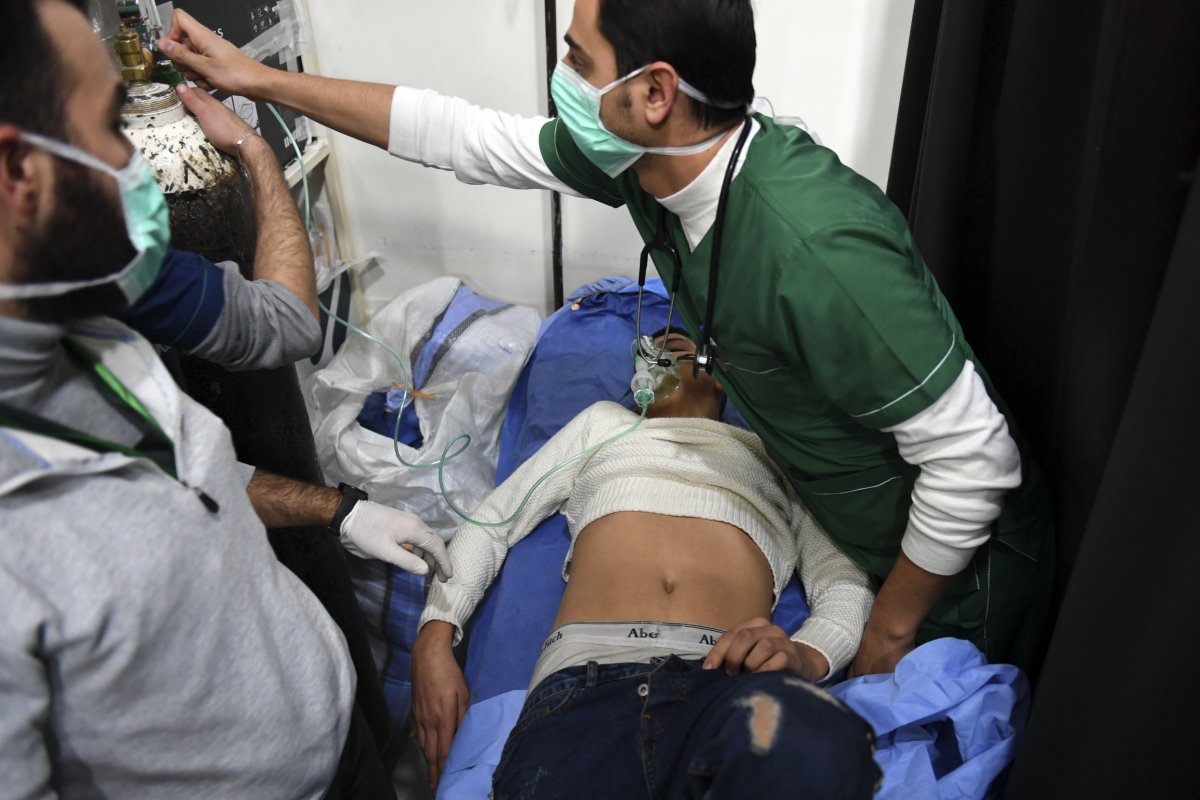The United States has accused Syria and Russia of using tear gas against civilians in an alleged "false flag" attack blamed on rebels and jihadis, which came around the same time the Trump administration received criticism for using the substance against asylum seekers at the U.S. border.
Up to 100 people were reportedly hospitalized on November 24 after a suspected chlorine attack struck Aleppo, Syria's most populous city. Aleppo has witnessed some of the most vicious fighting of the country's civil war and was held by forces opposed to Syrian President Bashar al-Assad until being retaken in a pro-government offensive backed by Russia and Iran two years ago. Damascus and Moscow blamed the incident on a nearby pocket of Islamist-led insurgents to the west, where Russian warplanes then conducted strikes in spite of an ongoing ceasefire.
The State Department disputed that narrative. In a statement, press director Robert Palladino claimed that "the Assad regime and Russia falsely accused the opposition and extremist groups of conducting a chlorine attack in northwestern Aleppo," and that the U.S. "has credible information that pro-regime forces likely used teargas against civilians" there.
"The United States has information indicating Russian and Syrian personnel were involved in the teargas incident, and believes that both countries are using it as an opportunity to undermine confidence in the ceasefire in Idlib," the statement read. "The United States is deeply concerned that pro-regime officials have maintained control of the attack site in its immediate aftermath, allowing them to potentially fabricate samples and contaminate the site before a proper investigation of it by the Organization for the Prohibition of Chemical Weapons."

The statement went on to say that "the United States is deeply concerned that pro-regime officials have maintained control of the attack site in its immediate aftermath, allowing them to potentially fabricate samples and contaminate the site before a proper investigation of it by the Organization for the Prohibition of Chemical Weapons.
"We caution Russia and the regime against tampering with the suspected attack site and urge them to secure the safety of impartial, independent inspectors so that those responsible can be held accountable."
Shortly after the release of that statement, the Russian Defense Ministry published the results of its own findings, alleging that it had found irrefutable evidence of the use of chemical weapons in Aleppo and wanted to "remind the U.S. Department of State that it was the Syrian government that immediately after the November 24 tragedy officially requested that OPCW experts arrive urgently in Aleppo for a fact-finding mission," as quoted by the Interfax news outlet.
About a day after the alleged attack occurred in Aleppo, civilians also came under fire thousands of miles away at the U.S. southern border with Mexico, where migrants and refugees—mostly from Central America—have attempted to cross into the U.S. en masse. Traditionally, the individuals at the San Ysidro Port of Entry near San Diego would be permitted to enter as their claims were processed, but anti-immigration policies put in place by President Donald Trump meant that they were instead greeted with a hard-line response that soon devolved into chaos.
U.S. Border Patrol agents fired tear gas at migrants, gathered by the international boundary, including women and children, causing scenes of panic. Trump would later say that this was a "very minor form" of the weapon, but Customs and Border Protection Kevin McAleenan told CNN that it was "standard law-enforcement-issue" tear gas. As a chemical agent, tear gas is officially classified as a chemical weapon and is banned from the battlefield.
The incident further divided the already polarizing debate about those seeking refuge in the U.S. from countries in Central America, where U.S. anti-communist military policies in the 1980s helped spark conflicts that ravaged the region. Conservative commentators such as Tomi Lahren said the scenes of women and children choking on tear gas "was the HIGHLIGHT" of her Thanksgiving Day weekend, while others, such as singer-songwriter Rhianna, referred to the response as an act of "terrorism."

Democratic Congresswoman Barbara Lee of California called for the deployment of U.N. inspectors to the border site, and Mexico opened its own international investigation into the incident, evoking scenes reminiscent of Syria. All sides of the conflict have been accused of using chemical weapons, but alleged instances of the government using toxic gases, such as chlorine and sarin, were attributed to the deaths of hundreds of civilians.
The Organization for the Prohibition of Chemical Weapons considers tear gas a chemical weapon if used as a method of warfare. The U.S. is one of 193 countries committed to this convention, and it can be used for domestic law enforcement purposes.
The Syrian government vehemently denied using chemical weapons and, joined by Russia, blamed Western powers for conspiring with local militants to stage alleged "false flag" attacks in order to draw U.S. military intervention. Two such incidents led the U.S. to conduct strikes against the Syrian government, which it had supported extensive efforts to overthrow before turning its attention largely toward battling the Islamic State militant group (ISIS) that emerged in the chaos gripping Syria and neighboring Iraq.
Meanwhile, conspiracy theorists in the U.S. argued that Border Patrol agents never used tear gas against migrants at the border and that the scenes were staged in order to vilify the Trump administration.
Uncommon Knowledge
Newsweek is committed to challenging conventional wisdom and finding connections in the search for common ground.
Newsweek is committed to challenging conventional wisdom and finding connections in the search for common ground.
About the writer
Based in his hometown of Staten Island, New York City, Tom O'Connor is an award-winning Senior Writer of Foreign Policy ... Read more
To read how Newsweek uses AI as a newsroom tool, Click here.








